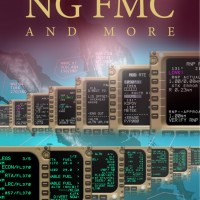
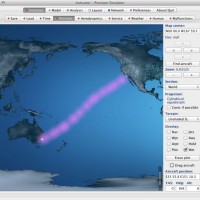
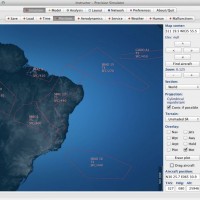
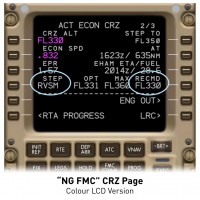
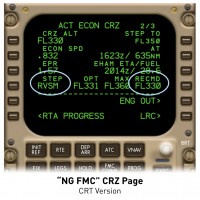
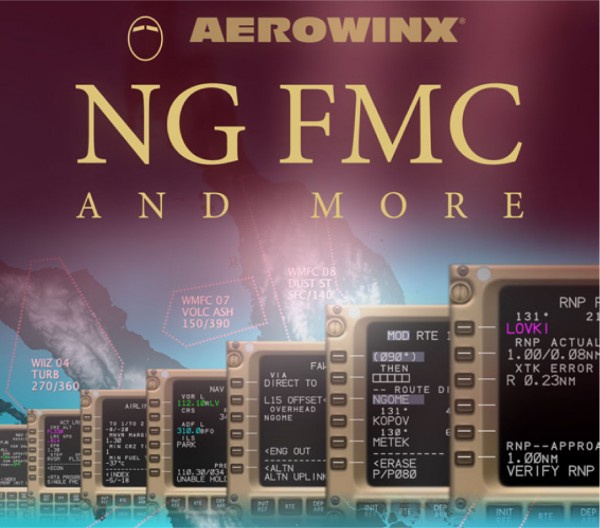
NG-FMC-AND-MORE
"NG FMC and More" is an upgrade package for PSX. It enables the simulation of the B744 NG FMC and provides bonus features described below.
BACKGROUND
In 2012 and following years, Boeing and Honeywell introduced new hardware and several software revisions for the B744 FMS under the title NG FMC, short for "Next Generation Flight Management Computer". All previous versions in this context are called "Legacy FMC".
The upgrade replaces the two legacy FMC units in the main equipment center with two NG FMC units. The existing control display units (CDUs) on the flight deck need not be replaced - they are compatible with the NG FMCs.
Most B744 aircraft in the real world are now equipped with NG FMCs. The upgrade was necessary because modern ATC procedures require a higher navigation performance. The NG FMC also provides more data uplink features for the preflight and inflight phases. Many useful functions regarding flight safety and pilot assistance have been added as well.
WHAT YOU GET
The NG FMC incorporates more memory, faster processors, and new software that provides enhanced LNAV/VNAV guidance to the autopilots, many additional textual controls to the CDUs, and more routing features to the navigation displays (note that the NG FMC upgrade for the B744 is slightly less comprehensive than the FMS of the B74-8; that would require further hardware components, and B744 aircraft are not fitted with that hardware). These new elements for the B744 are now modeled in Precision Simulator and are described in this NG FMC Manual; this manual does not discuss functions that are already included in the legacy FMC. For a description of the entire FMS, please refer to the Aerowinx Operations Manual.
FEATURES
- More memory (for up to 250 route legs, etc.)
- VNAV off-idle thrust descent for better speed control
- RF legs (constant radius to a fix)
- Additional waypoint data on the ND
- Change-over guidance on the ND for offset route transitions
- Holding pattern entry guidance on the ND
- FMC computed flap profile points on the ND
- Automatic FMC command speed changes at flap profile points
- RVSM step size logic
- FMC computed recommended CRZ ALT
- Cruise speed segments (CSS) option with ECON, LRC, Mach, RTA
- Speed-only constraints are allowed in climb and descent
- Vectors can be manually entered; automatic intersection calculation etc.
- Second top of descent for deceleration phase at cruise altitude
- Top of descent after level-off segments in descent
- Airline policy pages with editable TO 1 / TO 2 thrust derate values etc.
- New pages for the enroute management of alternate airports and diversions
- POS REF pages and NAV OPTION page with more control functions
- New PERF INIT page with data uplink functions
- New TAKEOFF REF pages with more parameters and with data uplink functions
- Data uplinks of alternate airports short-list, long-list, and inhibits
- Route data printout simulation
- Four FIX INFO pages and additional data entry formats
- And many other new details are included in the NG FMC
INCLUDED EXTRAS
- Simulation of multicolor LCD CDUs
- The flight deck may be equipped with LCD CDUs (liquid crystal displays)
- LCD CDUs show text from the NG FMCs in multicolor
- NG FMCs also work with conventional CRT CDUs - those just show all text in green
- The Wind & OAT corridor tools (advanced weather simulation)
- A tool on the Instructor can gather wind & OAT data from the internal planet weather model along the coordinates of the active FMC route and then fill a special text field on the Instructor screen with the scanned data. This text can be copied and used in external documents.
- Vice versa, the data in the text field can be edited or entirely pasted from an external flight plan weather document and then be embedded in the planet weather model. This way your flight plan weather will very much agree with the weather in the simulated flight scenario.
- The read and write system can handle five different airline specific formats that most companies use in their standard dispatch operations.
- The SIGMET tools (advanced weather simulation)
- Create special weather areas manually using the standard SIGMET format and embed these areas in the planet weather model.
- Or download a worldwide list of current real-world SIGMETs from the Internet and embed these in the planet weather model. This may be done by clicking a button, or the system may do it automatically circa every half an hour.
- Or copy a list of SIGMETs from an external flight plan document, paste it in a special text field on the Instructor screen, and embed these SIGMETs in the planet weather model by a simple mouse click. This way the weather in the simulated flight will agree with your flight plan documents
USER MANUAL & MORE INFO
The manual explains all features in greater detail. It can be downloaded free of charge from the Aerowinx web site: https://bit.ly/NgFmcManual-V1
SYSTEM REQUIREMENTS
- The NG FMC simulation upgrade must be activated by a license file
- Before the license can be applied:
- Precision Simulator version 10.93 or higher must be installed
- and must have been started at least once (the start process will generate the subfolder "Extra" which will be the place for the license file)
- Owners of the Aerowinx DVD version 10.0 or 10.1.7:
- receive free update to Precision Simulator version 10.93 and higher
- check the aerowinx.com website for the latest version
DOWNLOAD INSTRUCTIONS
- Complete the purchase
- An email link for the download will be sent to you shortly after
- Download and install